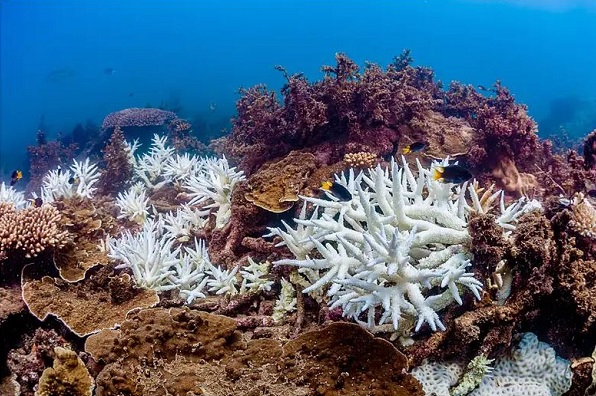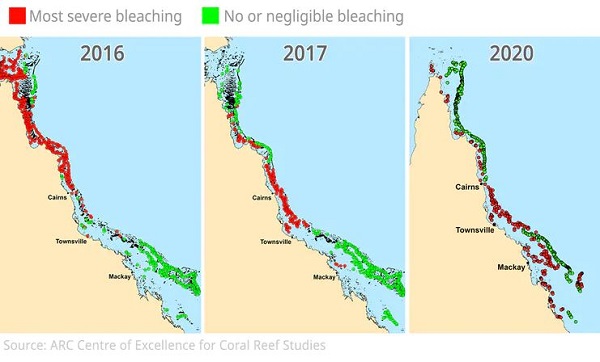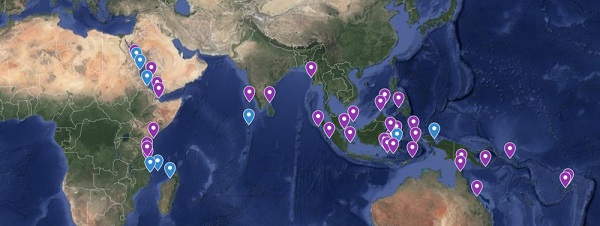
This post started as a Climate clippings which last appeared in August 30 last year. This post outgrew the CC format and ended up asking again Do we seriously want to save the great Barrier Reef?
Coral bleaching is becoming the new normal
From the New Scientist – The Great Barrier Reef has suffered its most widespread bleaching yet:
- Australia’s Great Barrier Reef has experienced its third mass bleaching event in five years. For the first time, all three sections of the reef have been severely affected.
The damage occurred in February when the reef was exposed to the hottest month of water temperatures on record.
Aerial surveys conducted by Terry Hughes at James Cook University in Australia and his colleagues during the last two weeks of March revealed that 25 per cent of the reef had been severely bleached and 35 per cent moderately bleached. The northern, central, and southern sections of the reef were all hit.
Severe bleaching also struck in 1998, 2002, 2016 and 2017, but was confined to one or two sections. This is the first time that all three sections have simultaneously experienced severe bleaching, says Hughes. “It’s heartbreaking.”
See also:
-
Terry Hughes and Morgan Pratchett – We just spent two weeks surveying the Great Barrier Reef. What we saw was an utter tragedy
Michael Slezak and Penny Timms – Great Barrier Reef found to be coral bleached from north to south for first time
Graham Readfearn – More than half of remote reefs in Coral Sea marine park suffered extreme bleaching
February was the hottest month of sea surface temperatures on BOM records, and that was the first bleach without an El Niño. The 2020 bleach is considered the second worst in the last five years. Here is a comparison:

The reef is adapting somewhat but at the expense of the branching coral which is home the most fish biodiversity.
Ove Hoegh-Guldberg talks about the likely loss of the Great Barrier Reef
ABC RN’s The Science Show is creating a new series Climate grief with interviews of people who have worked to save the planet from climate change. First is marine scientist Ove Hoegh-Guldberg, Professor in the School of Biological Sciences in the Faculty of Science at The University of Queensland talking with Jonica Newby who you might remember from ABC TV’s Calalyst.
It talks about his lifetime of love and work with the Great Barrier Reef. A quick check reveals that he is 61 and has published over 500 journal articles which been cited over 50,000 times.
There is still magic to be experienced on the Reef but it has changed drastically. On the optimistic version of what comes next he says that if we limit warming to 1.5°C by 2050, only 10 to 30 per cent of the GBR will remain, and it will be mostly of poorer quality than we inherited.
So why does he still work hard and with enthusiasm?
Work is being done to seed the reef with heat resistant variety of corals, but as Newby says you might do a tennis court-size patch of reef, but the GBR is the size of Italy.
Yet this is what Hoegh-Guldberg is doing in order to give future generations the best chance of re-establishing coral reefs from the ruins of global warming, which now seem inevitable, once emissions are stabilised.
He’s working on the 50 Reefs project a plan to triage the reefs with the best chance of survival. The plan was developed by The Ocean Agency during the filming of the 2017 Netflix Original Documentary Chasing Coral.
The initiative was developed:
- in partnership with the Global Change Institute at The University of Queensland and the Wildlife Conservation Society, and funded by Bloomberg Philanthropies, The Tiffany & Co. Foundation and Paul G. Allen Family Foundation.
See also:
The idea was to find the reefs that would last the longest under the threat of climate change, to protect them from over-fishing and pollution, and preserve them so that future generations can use them to seed and speed up the recovery of as much as possible of current reefs.
50 reefs were found in Indonesia, The Philippines, Madagascar, Solomon Islands, Fiji and Tanzania. Here’s a map of most of them:

Now they are trying to find out how to transplant and seed corals at scale, because at present they can only do four or five samples at a time.
The best we are being offered by the IPCC is a 50% chance of staying within 1.5°C which would require drastic annual reductions of GHG from 2020.
We may indeed get a temporary reduction from Covid 19, but UNFCCC meetings intended to lock in reduction plans at the December Conference of Parties in Glasgow are in disarray. Moreover, countries have shown a reflex action to draw in to a domestic focus, and away from global co-operation.
Within the major emitting countries climate action is on hold. At least Anthony Albanese in opposition sees using renewable energy and the revival of Australian manufacturing as central to remaking Australia rather than ‘snapback’ to a now illusory former ‘normality’.
Here in Queensland in early 2017 when looking at whether we really wanted to save the Great Barrier Reef Annastacia had just gone to India to lobby for the revival of the Adani Carnmichael mine proposal. Three year later she is still promoting new coal mines which are incompatible with saving the GBR.
Most IPCC scenarios involve overrun, a period when the temperature is higher than 1.5°C. It is sad that Ove Hoegh-Guldberg feels he has to devote his whole energy on triage action on the basis that this will happen, in order to facilitate a repair job that may be possible in the centuries to come when a new stabilisation of atmospheric GHG concentrations is found after the magic of life in the oceans has been shredded.

Brian:”The Great Barrier Reef is about 500,000 years old, but it hasn’t always looked as it does today. Reefs on Australia’s continental shelf have taken on many forms, depending on the sea level, and the current formation is about 6,000 to 8,000 years old.Sep 14, 2012.”
AND
“It is sad that Ove Hoegh-Guldberg feels he has to devote his whole energy on triage action on the basis that this will happen, in order to facilitate a repair job that may be possible in the centuries to come when a new stabilisation of atmospheric GHG concentrations is found after the magic of life in the oceans has been shredded.”
And: “The Great Barrier Reef is about 500,000 years old, but it hasn’t always looked as it does today. Reefs on Australia’s continental shelf have taken on many forms, depending on the sea level, and the current formation is about 6,000 to 8,000 years old.Sep 14, 2012.”
I would be irresponsible not to try as much triage as possible but it would take a political miracle or the dramatic failure of the fight against COVID-19 t retain anything like the current majesty of the barrier reef.
John, I’m not sure what you are saying. Corals have been around for about 300 million years. In the ‘big dying’ of 250 million years ago they were wiped out and took about 4 million years to re-establish. In our time the Holocene has been especially good for them as it has been for us.
I think it’s more than sad that the best we are being offered at present by politicians in Australia (including Greens and Labor) is the near total destruction of what we inherited.
As you know I want people to be aspiring to zero net emissions ASAP and by 2030 at the latest.
I know that we can’t do it alone. There is a lot of excitement about the possibility and indeed investments to export hydrogen and ammonium, and some of the initiatives to create green steel and revive manufacturing may come off.
It’s not enough, however, because major economies are at best signed up to zero by 2050 and hence the destruction of the GBR. They seem to think young people should get excited and support that.
I’m grateful that Hoegh-Guldberg is doing what he’s doing, but sad that it has come to this.
Brian: “Youth activists challenge Clive Palmer’s Waratah Coal mine saying it impacts their human rights.” https://www.abc.net.au/news/2020-05-13/youth-activists-challenge-clive-palmers-waratah-coal-mine/12239570
David Morris, chief executive of the Environmental Defenders Office, said:
“The link between human rights and climate change is increasingly being seen in legal actions around the world,”
“It was only a matter of time before we saw one in Australia.”
The action is being taken by a new group called Youth Verdict against the Galilee Coal Project in central Queensland — a project of Clive Palmer’s company Waratah Coal.
Youth Verdict has lodged an objection to the mine in the Queensland Land Court, arguing it infringes on a number of their rights under the state Human Rights Act, including the right to life, the protection of children and the right to culture.
“We’re facing a future that is increasingly uncertain, and that impacts our right to have a safe future,” Mel McAuliffe, one of the founders of Youth Verdict.
“It means we won’t have access to the same opportunities that generations before us have had.”
My first reaction was ho-hum but when I thought about it the legal challenge is quite right. The youth of the world is facing a very very bleak future in their lifetimes unless climate change is brought to a very quick halt. It is not just the loss of icons like the barrier reef. It is also about starvation, climate wars and…….
No surprise that LNP Senator Matt Canavan said although he was not aware of the specifics of the court case, he says these sorts of challenges usually fail.
“We know from the strategies of other environmental groups that they have sought to use our court system just simply to delay projects, not necessarily to protect the environment or even win the court case,” Senator Canavan said.
“I just don’t think our court systems are set up to handle such a disputed political issue. That’s not their role and purpose and [to] try to retrofit them to this will just cause more division and angst in our community”
Charging Kanavan and his ilk with encouraging treason does not seem all that unreasonable given the threat to the human rights of the youth of our world.
In an interview just after the election, Labor front-bencher Tony Burke identified climate change as an intergenerational equity/justice issue.
I wish Youth Verdict well and every success.
However, the big crime against humanity by people like Adani, Clive Palmer, Gina Rinehart etc is not digging up coal. The people who burn the coal are the criminals. We are hypocrites if we refuse to supply while we are burning it ourselves.
Palmer and co’s crime is mainly been lobbying politicians to favour the continued use of fossil fuels and in Palmer’s case, of corrupting the electoral process.
The greenies and The Greens often attack peripheral targets. For many years they attacked farmers for wrecking the GBR with farm runoff, when that issue was marginal to the direct effects of global warming.
Now this ‘Scope 3’ concept has been designed, I think by Climate Analytics, and has largely been misused. It’s main value is to assess the risk of stranded assets within a national economy, or within a company, or an investment portfolio. In this regard the latest is Westpac, who recently announced they will be out of financing fossil fuels by 2030, the 32nd announcement of this type this year.
We badly need public spokespeople saying that allowing warming of 1.5°C is basically insane. Even Greta Thunberg is not saying this directly. The island states who proposed 1.5°C will still be inundated. Bushfires will get worse. Ross Garnaut said the other day that the Murray Darling system is heading for a 90% drop in stream flow by the end of the century. Food bowls in Asia and cities in Asian will be inundated. Senior climate scientists warn that we may have already passed tipping points.
Meanwhile the term ‘climate emergency’ has been emptied out of real meaning to become almost meaningless.
I would have thought that coral bleaching provided an excellent opportunity for calling for genuinely urgent action and the need to draw down existing emissions. Aila Keeto gave an excellent address in the John Sinclair Memorial Lecture I think in early February, but the media, the greenies and the Greens did not pick up on it.
I’ll post on Keeto’s speech soon, I hope.
I think, judging by our words and deeds, people are not seriously trying to save the GBR. Ove Hoegh-Guldberg is working on making it easier for humans not yet born who may inhabit the Anthropocene next century to help build a new reef. The GBR will exist in archival footage.
Brian: Scientists push to raise awareness of Great Southern Reef https://www.abc.net.au/news/2020-05-19/great-southern-reef-needs-more-attention-scientists-say/12227998. The giant kelp forests and the ecology they support are important even if they aren’t as garish as the GBR.
Global warming is killing the kelp forests and, unlike the GBR the kelp forrest species have no where further south to go.